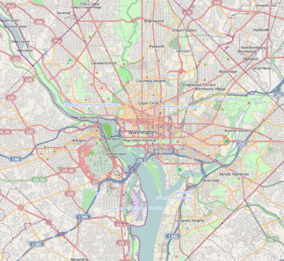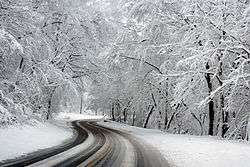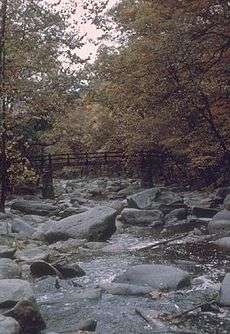Rock Creek Park
| Rock Creek Park | |
|---|---|
|
IUCN category V (protected landscape/seascape) | |
|
Maryland border entrance | |
| Location | District of Columbia, United States |
| Nearest city | Washington, D.C. |
| Area | Over 2000 acres (3 mi2)[1] |
| Established | September 27, 1890 |
| Visitors | 2,115,516 (in 2004) |
| Governing body | National Park Service |
|
Rock Creek Park Historic District | |
 Rock Creek Park | |
| Location | Roughly, Rock Creek Park from Klingle Road to Montgomery County line, Washington, District of Columbia |
| Coordinates | 38°57′27″N 77°2′42″W / 38.95750°N 77.04500°WCoordinates: 38°57′27″N 77°2′42″W / 38.95750°N 77.04500°W |
| Area | 1754 acres (2.74 mi2)[1] |
| Built | 1820s (Peirce Mill); 1897-1912 (Park facilities) [2] |
| Architect | Frederick Law Olmsted, Jr., John Charles Olmsted |
| Architectural style | Late Nineteenth and Twentieth Century Revivals, Early Republic, and NPS Rustic |
| NRHP Reference # | 91001524 [3] |
| Added to NRHP | October 23, 1991 |
Rock Creek Park is a large urban park that bisects the Northwest quadrant of Washington, D.C. The park was created by an Act of Congress in 1890, and today is administered by the National Park Service. In addition to the park proper, the Rock Creek administrative unit of the National Park Service administers various other federally owned properties in the District of Columbia located to the north and west of the National Mall, including Meridian Hill Park on 16th Street, N.W., the Old Stone House in Georgetown, and certain of the Fort Circle Parks, a series of batteries and forts encircling the District of Columbia for its defense during the U.S. Civil War.
History
Rock Creek Park was established by an act of Congress signed into law by President Benjamin Harrison on September 27, 1890, following active advocacy by Charles C. Glover and other civic leaders and in the wake of the creation of the National Zoo the preceding year.
It was only the third national park established by the U.S., following Yellowstone in 1872 and Mackinac National Park in 1875. Sequoia was created at the same time, and Yosemite shortly thereafter. In 1933, Rock Creek Park became part of the newly formed National Capital Parks unit of the National Park Service.
The Rock Creek Park Act authorized the purchase of no more than 2,000 acres of land, extending north from Klingle Ford Bridge in the District of Columbia (approximately the northern limit of the National Zoo), to be "perpetually dedicated and set apart as a public park or pleasure ground for the benefit and enjoyment of the people of the United States".[4] The Act also called for regulations to "provide for the preservation from injury or spoliation of all timber, animals, or curiosities within said park, and their retention in their natural condition, as nearly as possible".[5] Rock Creek Park is the oldest natural urban park in the National Park System.[6] Park construction began in 1897.[2]
In 1913, Congress authorized creation of the Rock Creek and Potomac Parkway and extended the park along a narrow corridor from the zoo to the mouth of Rock Creek at the Potomac River.[7] The parkway is a major traffic thoroughfare, especially along the portion south of the zoo. The park is patrolled by the United States Park Police.
Description

The main section of the park comprises 1754 acres (2.74 mi2, 7.10 km2), along the Rock Creek Valley. Including the other green areas the park administers (Glover Archbold Park, Montrose Park, Dumbarton Oaks Park, Meridian Hill Park, Battery Kemble Park, Palisades Park, Whitehaven Park, etc.), it encompasses more than 2000 acres (3 mi2, 8 km2).
The parklands follow the course of Rock Creek across the D.C.-Maryland border to connect with Rock Creek Stream Valley Park and Rock Creek Regional Park in Montgomery County. The Maryland parks are operated by the Maryland-National Capital Park and Planning Commission.
The Rock Creek Historic District was listed on the National Register of Historic Places on October 23, 1991.[8]

Recreation facilities include a golf course; equestrian trails; sport venues, including a tennis stadium which hosts major professional events; a nature center and planetarium; the Carter Barron Amphitheatre, an outdoor concert venue; and picnic and playground facilities. Rock Creek Park also maintains cultural exhibits, including the Peirce Mill. Rock Creek is a popular venue for jogging, cycling, and inline skating, especially on the long, winding Beach Drive, portions of which are closed to vehicles on weekends.[1]
A number of the city's outstanding bridges, such as the Lauzun's Legion, Dumbarton, Taft and the Duke Ellington bridges, span the creek and ravine.
Among the park's few monuments is a pink granite bench on Beach Drive south of the Peirce Mill, dedicated on November 7, 1936 by President Franklin Delano Roosevelt in memory of former French ambassador Jean Jules Jusserand. [9] In 2014 it was named "best obscure memorial" by Washington City Paper.[10]
Horse Center
Rock Creek Park Horse Center, founded in 1972, is located in the middle of the park near the Nature Center. The barn, run by Guest Services Inc, has 57 stalls, two outdoor rings, one indoor ring, and three bluestone turnout paddocks. The stable provides trail rides, pony rides, and lessons for the public, along with boarding for private horses. The stable primarily teaches English riding, with an emphasis on lower-level jumping and dressage.[11]
The barn is also home to Rock Creek Riders, a therapeutic riding program for adults and children with special needs in the DC area. Past participants in the program include brain injured veterans of the conflicts in Iraq and Afghanistan and people with autism, cerebral palsy, or attention deficit disorder. The program is volunteer-run and relies on donations and contributions for funding. Previously, Rock Creek Riders has worked with the United States Mounted Police, National Park Service, Wounded Warrior Project, and the Caisson Platoon Equine Assisted Programs to provide these therapeutic riding services. [12]
The horse center's summer camps are popular with DC residents. The stable offers summer camp from 9-3 for children over eight, and a two-hour afternoon camp for children between five and eight years old. The stable also recently implemented a summer CIT training program for teenagers.
Peirce Mill

Peirce Mill is a water-powered grist mill in Rock Creek Park. There were at least eight mills along Rock Creek within what is now Washington D.C., and many more farther upstream in Montgomery County, Maryland. Of those eight, only Peirce Mill is still standing.
It was built in the 1820s by Isaac Peirce, along with a house, barn, and other buildings. It was later owned by a son, Joshua Peirce, and a nephew Peirce Shoemaker. It became part of Rock Creek Park in 1892.[13]
The family consistently spelled their name "Peirce" (except for some of Isaac Peirce's ancestors who went by Pearce). Others often use "Pierce" but not the family. Evidence includes family gravestones, family Bible, and estate book from Joshua Peirce, and living descendants who still use the old spelling.
The mill was listed on the National Register in 1969 as Peirce Mill.[3] It was repaired and re-opened October 15, 2011.
The Peirce Carriage Barn, adjacent to the mill, usually is open every day. The barn is the National Park Service point of contact. The barn was part of the Peirce estate built in 1810 and used as a tack room and carriage barn. The barn is now a mini museum containing information on the milling process, the Peirce family estate and other mills along the Rock Creek Valley.
Administration
As originally authorized by Congress, the park was governed by the Rock Creek Park Commission, comprising the Chief of Engineers of the Army, the engineer commissioner of the District of Columbia, and three presidential appointees. In 1933, the park, along with other National Capital Parks, was transferred to the jurisdiction of the National Park Service.[14]
"Rock Creek Park" is also an administrative unit of the National Park Service responsible for administration of 99 properties in the District of Columbia north and west of the National Mall and Memorial Parks. The properties include various parks, parkways, buildings, circles, triangles, memorials, and statues and include: [4]
- Barnard Hill Park
- Battleground National Cemetery
- Bryce Park – Massachusetts Avenue between Wisconsin Avenue and Garfield Street, NW
- Chevy Chase Circle
- Fort Circle Parks – from Palisades Park to Fort Lincoln
- Dumbarton Oaks Park
- Francis Asbury Memorial
- Francis Scott Key Park - located at 34th and M Streets, NW
- Glover-Archbold Park
- Georgetown Waterfront Park
- Grant Circle
- Guglielmo Marconi Memorial
- James Cardinal Gibbons Memorial
- Klingle Valley Parkway
- Francis G. Newlands (Little Forest) Park – Military Road between 28th and 30th Streets, NW
- Major General George B. McClellan Memorial
- Melvin C. Hazen Park – South of Tilden Street on either side of Connecticut Avenue, NW
- Meridian Hill Park
- Montrose Park
- Normanstone Parkway – Along Normanstone Drive across Massachusetts Avenue, NW from the US Naval Observatory
- Old Stone House
- Rabaut Park
- Peter Muhlenberg Memorial
- Piney Branch Parkway
- Robert Emmet Memorial
- Rock Creek and Potomac Parkway
- Sherman Circle
- Soapstone Valley Park
- Tenley Circle
- Ward Circle
- Wesley Heights Park – Along Fulton and Edmunds Streets, NW, connecting Palisades Park to Glover-Archbold Park
- Westmoreland Circle
- Whitehaven Park – South of W Street, NW connecting Glover-Archbold Park to Dumbarton Oaks Park
- Woodley Playground – Courtland and Devonshire Places, NW
Montrose and Dumbarton Oaks Parks
Montrose Park occupies land that belonged to Robert Parrott. Adjacent to it is Dumbarton Oaks Park, which preserves the grounds of the former Dumbarton Oaks estate. The house and its formal garden are not part of the park.
Both parks were listed on the National Register of Historic Places on May 28, 1967.
Old Stone House
The Old Stone House, the oldest building in Washington, D.C., is a simple eighteenth century dwelling. The house is a popular museum, showcasing the everyday life of middle class colonists. It was purchased by the federal government in 1953 and has been open to the public since the 1960s. The house is located in the Georgetown neighborhood, not on land contiguous with Rock Creek Park, but the property is managed by park staff.
Demographic significance
Though D.C.'s quadrants (i.e., Northwest, Southwest, Northeast, and Southeast) are the primary geographic metonyms for racial and class divisions, as Rock Creek Park separates prominent neighborhoods such as Georgetown, Cathedral Heights and Spring Valley from the rest of the city, the designations WOTP (West of the Park) and EOTP (East of the Park) also serve this role.[15]
Legislative History
Congressional authorizations:
- Rock Creek Park – September 27, 1890
- Meridian Hill Park – June 25, 1910
- Montrose Park – March 2, 1911
- Rock Creek & Potomac Parkway – March 4, 1913
- Dumbarton Oaks Park – December 2, 1940[16]
See also
- Battleground National Cemetery
- Fort Stevens
- Linden Oak
- Meridian Hill Park
- Old Stone House (Washington, D.C.)
- Pierce-Klingle Mansion
- List of parks in the Baltimore–Washington metropolitan area
References
- 1 2 3 Rock Creek Park, District of Columbia. "Frequently Asked Questions." National Park Service, U. S. Dept. of the Interior. Last updated 2014-08-15. Accessed 2014-08-23.
- 1 2 Construction of initial roads, bridle paths and foot paths took place during 1897-1912. Mackintosh, Barry (1985). "Under Military Rule". Rock Creek Park: An Administrative History (Report). Washington, DC: National Park Service (NPS).
- 1 2 National Park Service (2009-03-13). "National Register Information System". National Register of Historic Places. National Park Service.
- 1 2 NPS (March 2010). "Rock Creek Park Long Range Interpretive Plan."
- ↑ NPS (1985). "Success." An Administrative History, Rock Creek Park.
- ↑ "Our Wild Heart - A Tribute to Rock Creek Park", Washington Post, July 11, 2014
- ↑ NPS (2004). "Parkway and Other Additions." Rock Creek Park: An Administrative History.
- ↑ Record display, National Register of Historic Places
- ↑
- NPS. "Rock Creek Park: Monuments, Statues and Memorials." 2013-01-05.
- ↑ Michael E. Grass (2014). "Best Obscure Memorial: Jules Jusserand Memorial". Washington City Paper.
- ↑ "Rock Creek Park Horse Center". Rockcreekhorsecenter.com. Retrieved 2014-03-26.
- ↑ "Equine Therapeutic Activities in Rock Creek Park". Rock Creek Riders. 2014-01-27. Retrieved 2014-03-26.
- ↑ NPS (2004). "Under Military Rule: Peirce Mill." Rock Creek Park: An Administrative History.
- ↑ NPS (2004). "Under the Park Service: The Changing of the Guard." Rock Creek Park: An Administrative History.
- ↑ Peterson, Britt (September 2015). "East of the Park vs. West of the Park: Which One Are You?". Washingtonian. Retrieved August 31, 2015.; for an example of this in political discussion, see Archer, Ken (November 16, 2012). "DC Drifting towards Separate School Systems. Are they Equal?". Greater Greater Washington. Retrieved August 31, 2015.
- ↑ NPS (2004). "Appendix A—Legislation." Rock Creek Park: An Administrative History.
External links
| Wikimedia Commons has media related to Rock Creek Park. |
- National Park Service: Rock Creek Park
- Dumbarton Oaks
- Friends of Peirce Mill
- Rock Creek Conservancy
- Rock Creek Park Documentary produced by WETA-TV

